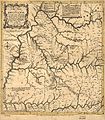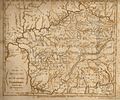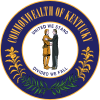The Kentucky Portal  Kentucky (US: /kənˈtʌki/ ⓘ kən-TUK-ee, UK: /kɛn-/ ken-), officially the Commonwealth of Kentucky, is a landlocked state in the Southeastern region of the United States. Kentucky borders Illinois, Indiana, and Ohio to the north, West Virginia to the northeast, Virginia to the east, Tennessee to the south, and Missouri to the west. Its northern border is defined by the Ohio River. Its capital is Frankfort and its largest city is Louisville. As of 2020, the population was approximately 4.5 million. Kentucky was admitted into the Union as the 15th state on June 1, 1792, splitting from Virginia in the process. It is known as the "Bluegrass State", a nickname based on Kentucky bluegrass, a species of green grass introduced by European settlers for the purpose of grazing in pastures, which has supported the thoroughbred horse industry in the center of the state. Historically, Kentucky had excellent farming conditions, which led to the development of large tobacco plantations similar to those in Virginia and North Carolina in the central and western parts of the state that utilized enslaved labor during the Antebellum South and Civil War periods. Kentucky ranks fifth nationally in goat farming, eight in beef cattle production, and 14th in corn production. While Kentucky has been a long-standing major center for the tobacco industry, the state's economy has diversified in multiple non-agricultural sectors, including auto manufacturing, energy fuel production, and medical facilities. The state ranks 4th among US states in the number of automobiles and trucks assembled. Kentucky is one of several states considered a part of the Upland South. (Full article...) Entries here consist of Good and Featured articles, which meet a core set of high editorial standards.
 Martha Watts (February 13, 1848 – December 30, 1909) was an American missionary and school teacher who established four educational facilities in Brazil. Educated in Kentucky at the Louisville Normal School, she was in the first graduating class in the early 1870s and became a teacher, working in the public schools. After joining the Broadway Methodist Church in 1874, Watts joined a youth missionary society and founded a Sunday school class. In 1881, after applying to the Women's Board of Foreign Missions, she was accepted as the second woman from the United States to act as a foreign missionary and was the first woman to be sent to Brazil. Arriving in the state of São Paulo in 1881, Watts' mission was to establish a school in Piracicaba. Within months, though she only had one student, Watts had opened the Colégio Piracicabano and began by recruiting a French teacher, Marie Rennotte, in 1882. At the time, most educational materials had been translated into French, as it was the universal language of education. The two women worked together to design an innovative co-educational learning environment, which offered courses in languages, literature, mathematics, philosophy, and the natural and physical sciences. Though criticized by conservative sectors of society and the Catholic Church, Watts gained powerful supporters, including prominent progressive politicians, lawyers, masons, and abolitionists. By the 1890s, the school method and curricula had gained wide support, the student body had grown substantially, and their methods were being implemented throughout the state. (Full article...)Selected article -Thomas Hunt Morgan (September 25, 1866 – December 4, 1945) was an American evolutionary biologist, geneticist, embryologist, and science author who won the Nobel Prize in Physiology or Medicine in 1933 for discoveries elucidating the role that the chromosome plays in heredity. Morgan received his Ph.D. from Johns Hopkins University in zoology in 1890 and researched embryology during his tenure at Bryn Mawr. Following the rediscovery of Mendelian inheritance in 1900, Morgan began to study the genetic characteristics of the fruit fly Drosophila melanogaster. In his famous Fly Room at Columbia University's Schermerhorn Hall, Morgan demonstrated that genes are carried on chromosomes and are the mechanical basis of heredity. These discoveries formed the basis of the modern science of genetics. (Full article...)General images -The following are images from various Kentucky-related articles on Wikipedia.
Did you know -
Related portalsTopicsNational Register of Historic Places listings in Kentucky by county
Largest citiesCategoriesNew articlesThis list was generated from these rules. Questions and feedback are always welcome! The search is being run daily with the most recent ~14 days of results. Note: Some articles may not be relevant to this project.
Rules | Match log | Results page (for watching) | Last updated: 2024-04-17 23:30 (UTC) Note: The list display can now be customized by each user. See List display personalization for details.
WikiProjectsTasks
Associated WikimediaThe following Wikimedia Foundation sister projects provide more on this subject:
Sources
Discover Wikipedia using portals |











































